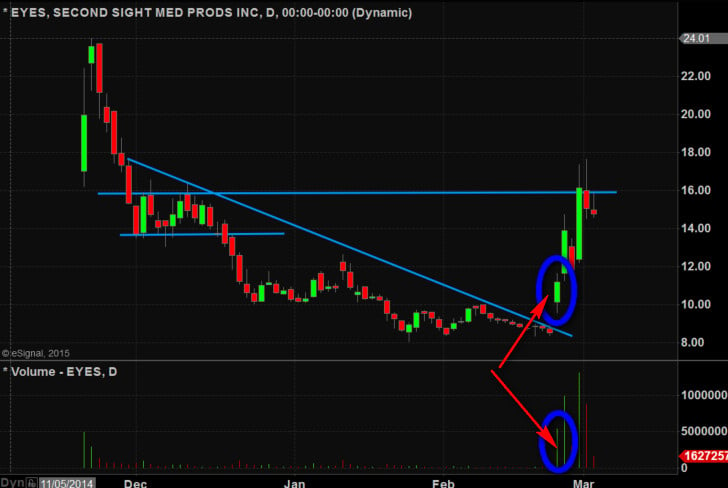A large part of traders’ decision making is based on processing information visually. A few days ago I posted “Open Your Eyes” which shared a daily chart for the ticker $EYES. I asked for feedback from our community on which part of the chart was most significant. Check the comments section of the post for some good sharing.
When I look at the below chart the day that jumps out at me is February 24th. A few significant things happened on that day: 1)the volume exceeded all prior trading days even the day of the IPO which often is the highest volume day in a stock’s history; 2)the intra-day range expanded dramatically from the prior two weeks; 3)a multi-month downtrend ended.
In my experience a huge change in price and volume, which clearly reverses a prior trend, often leads to significant follow through. The size of the follow through moves tend to be even larger for lower priced stocks. I have posited on many occasions the reason for this is that large traders or even small funds have enough buying power to buy significant portions of the stock’s float. Also, there are thousands of short term traders that scan for this scenario who then begin to trade these setups and add more fuel to the fire.
These setups often lead to dramatic down moves after a few days of up. But those who try to short the first day or two of up are usually just providing liquidity for momentum traders jumping on a freight train that can continue higher for a few days. There almost is never a fundamental reason that justifies the dramatic increase in price. It is truly a function of a large temporary supply/demand imbalance. The vast majority of traders in my experience love to short these stocks because they know eventually they will be cut in 1/2 or more. The problem of course arises in that these traders become so concerned that they will miss the big down move that they short far too early. We use to see this on our trading desk all the time, and as our traders became more experienced in these setups they tend to get involved closer to the top.
You may ask why don’t more traders pile on the long side and just flip to short once there is a clear change in price action. Partly it is because most traders are thinking this move is BS and partly it is that stocks usually drop more dramatically than they go up. The most common advice I give to developing traders is to not short on “Day 1”. This is when a stock first begins to break out. It is extremely rare for a stock’s volume to increase by several hundred percent and completely reverse on the first day. In fact, this is a great day to get involved on the long side. Because as the stock moves higher and higher it appears on more traders’ radar and fuel gets added to the fire. And if it is a real company the financial press will jump on the bandwagon as well, which encourages more retail traders to get long.
The first rule of trading is to control your risk. Far too many times over the years I have received emails from people who have blown up by shorting this scenario and not controlling their risk.
Steven Spencer is the co-founder of SMB Capital and SMB University which provides trading education in stocks, options, forex and futures. He has traded professionally for 18 years. His email address is: sspencer@smbcap.com.
No relevant positions


